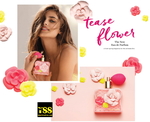Elizabeth Arden Babani Adverts 1920-25: Mission Civilisatrice & Early Perfume Layering in 1925 {Perfume Adverts}
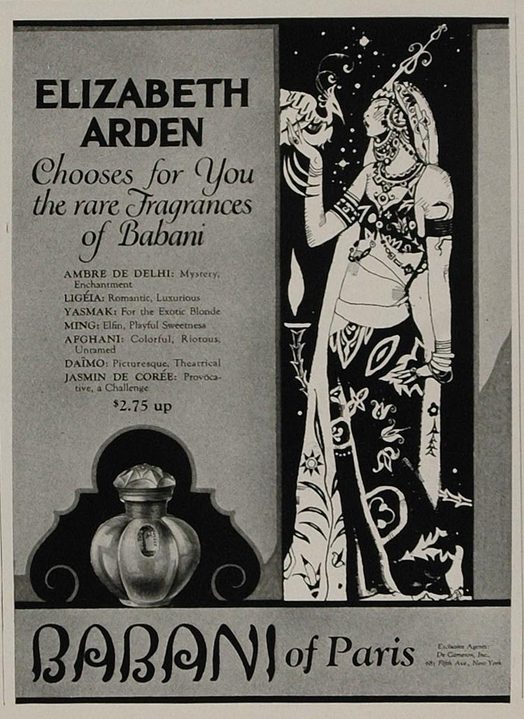
We found a series of interesting adverts by Elizabeth Arden about their early fragrance co-label, Babani. Babani was presented as a partner and correspondent of the Arden brand located in the French capital - Babani of Paris - with that implicit allusion to a French legitimizing process in the field of perfumery which was important in those days. The perfumes were said on the ads to be bottled in France and imported to the USA to reassure consumers.
The house of Vitaldi Babani was established ca. 1895. They were known for their oriental imports and their bohemian-style embroidered silk velvets.
In 1919, Maurice Babani was the second couturier - after Paul Poiret and before Coco Chanel - to introduce perfumes as part of a fashion label accessories range. He was more self-conscious than Poiret about it, and less so than Chanel.
There is above a 1923 advert which mentions several Babani scents: Ambre de Delhi, Ligéia, Yasmak, Ming, Afghani, Daïmo, Jasmin de Corée. They are alluring because they are offered as being both rare and exotic. One of the main tag lines for Babani in 1920 was, "Parfums inconnus d'Orient et d'Extrême-Orient" (lit. Unknown perfumes of the Orient and Far-East); the "unknown" part was dropped by 1923.
What was exported also, we can easily understand, was not just French essences, but Parisian chic.
In an another 1923 advert (not shown here), Babani clearly addressed themselves "To American women" via Elizabeth Arden in a sort of magical prophetic dervish-like way, bringing them in one stroke of the perfume-advertising pen, fine-fragrance civilization. It was, in a way, modeled after the prevalent colonialist ideology of the period, the idea that there existed a mission civilisatrice but extended here to the new world in the particular field of beauty. The collection of Babani fragrances was itself very much in tune with an Exposition-Universelle mental framework where all the best goods from the colonies were episodically laid at the feet of Western urbanites.
In 1925 (below), we find more explicitly stated the marketing and aesthetic proposition of layering the Babani fragrances (not more than two at a time here; up to three elsewhere) to capture that even rarer essence: the unique reflection of your personality. It is a concept that is now systematically explored by a brand like Jo Malone for example but more from the standpoint of the harmony between the scents themselves than from that of your own personality or mood, although the latter emphasis appears a bit with L'Artisan and other brands...
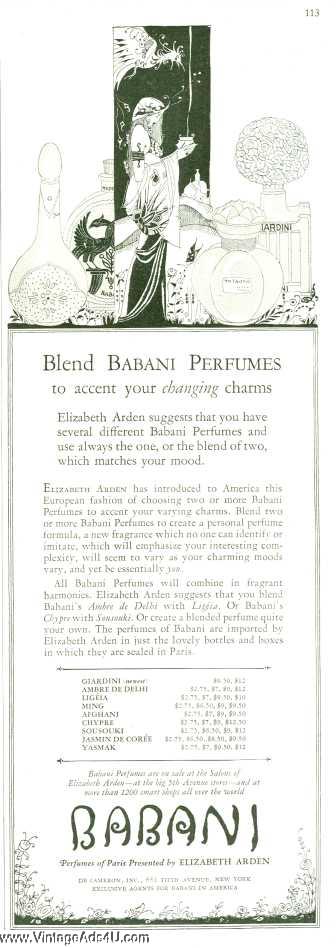
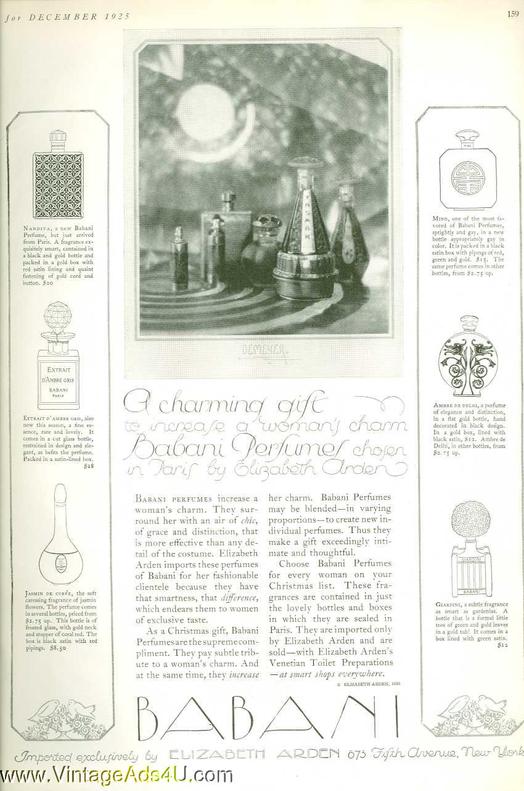
Is the layering proposition a modern adaptation, made in USA, at least as a marketing concept? It would be tempting to consider this possibility since even today scent layering is not exactly widespread or widely advertised, especially in France, and purists would consider it low-brow practice.
Here is an excerpt from a 1925 Arden booklet explaining the layering concept of the house of Babani,
"To emphasize your charm you need at least two Babani Perfumes - each one, in itself, expressive of a phase of your individuality. And these two basic perfumes you will blend to make a third fragrance essentially personal and unique. This is the way in which the fashionable women in Paris and of all Europe are using their exceedingly smart perfumes of Babani. Surely there is no more delightful method of expressing the interesting complexity of your nature! Blending these exquisite odors becomes a delicate art, a means of accenting your varied charms with grace and subtlety. Babani offers these suggestions to guide you in the correct use of his perfumes (Editor's note: follows a list of perfume layering suggestions according to personality type.)"
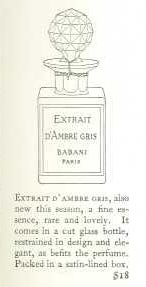
In that other 1925 ad (shown above and left), also from Harper's Bazaar, what struck me was the bottle of Extrait d'Ambre Gris because I mistook it for a moment for the Balmain Ambre Gris flacon due to the comparable shape and lettering.
Babani or the indispensable mysterious Oriental-cum-Parisian dimension of the Elizabeth Arden perfume brand in the 1920s. Parallel to this co-labeling strategy, Arden did start developing prudently some simpler perfumes under her own name, with less of the mystique of the Orient about them and with no claim to complexity, as early as 1922 with her debut scent, Arden Jasmin followed by Arden Rose.
Blue Grass and Kentucky-horse-country roots would be introduced later on in 1934 when the label would be more self-assured, independent and would decide to talk to American women from within the mainland, not even from the city, but the countryside.
Photo credit: also Vintage Art
Sources: Vintage Fashion Guild; Cleopatra's Boudoir
Today I also reviewed the 8-Hour Cream by Arden in the 1950s vintage packaging.









